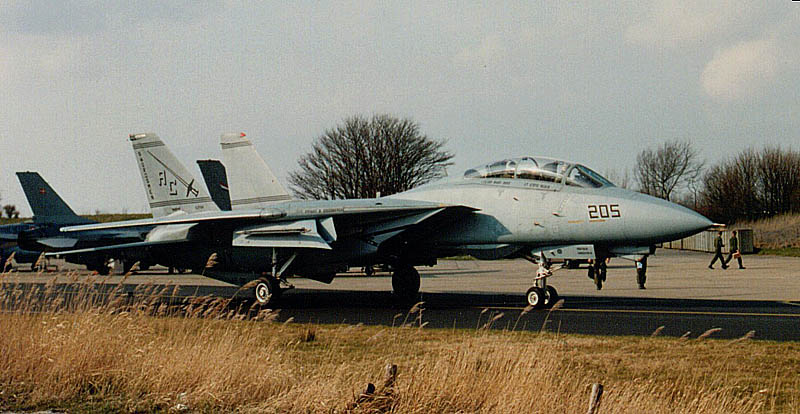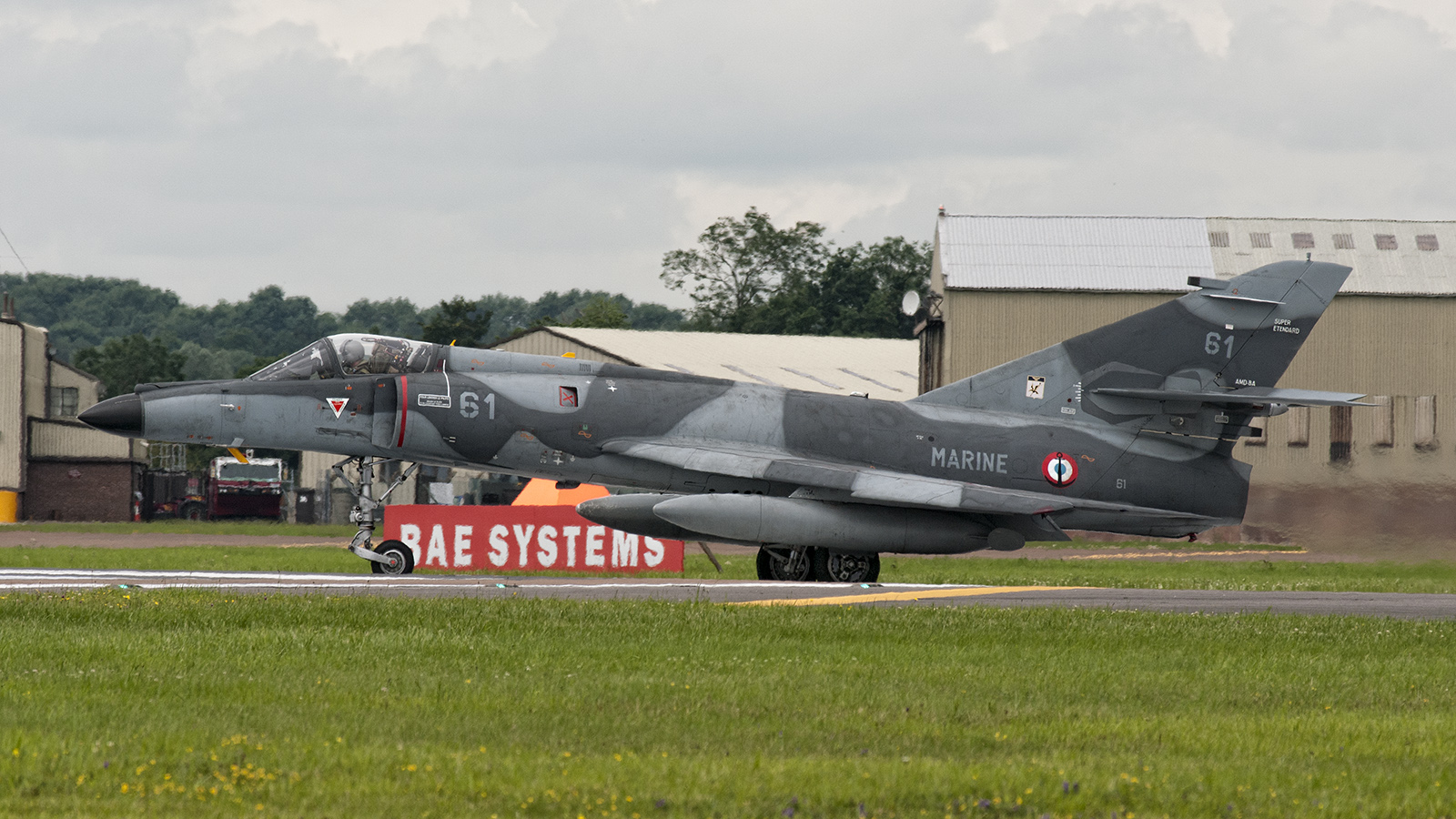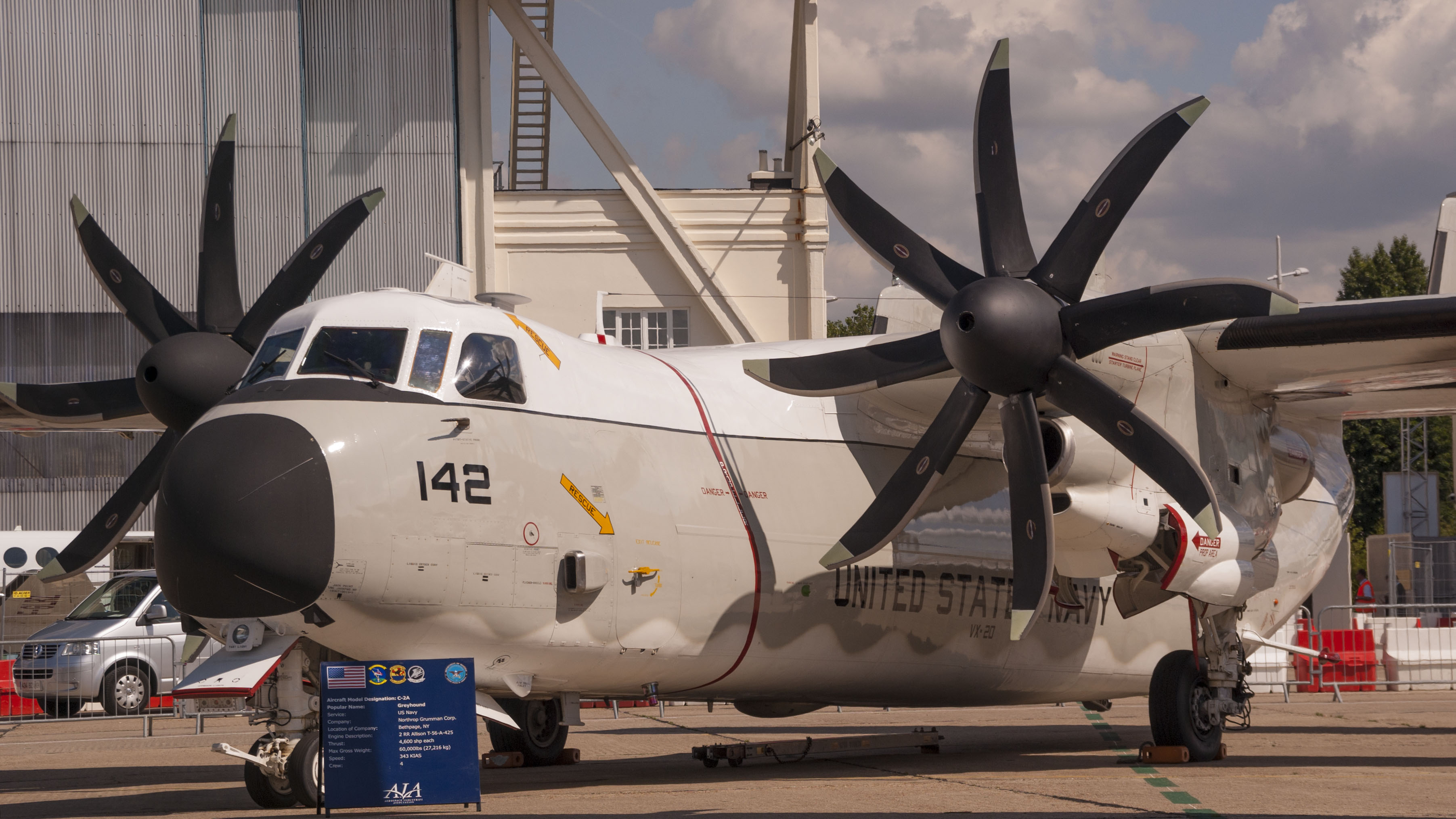
The Grumman F-14 Tomcat is a supersonic, twin-engine, variable sweep wing, two-placed fighter designed to attack and destroy enemy aircraft at night and in all weather conditions, from carriers or shore based.
Three basic versions have been developed for service with the US Navy. First was F-14A (# 557) (including 12 YF-14A pre-production Tomcats) built for the Navy.
The first flight (with the 157980) on December 21st 1970 was a short hop with the wings kept in fully forward position. The second test flight on December 30th 1970 ended in disaster, during this flight the aircraft suffered a primary hydraulic system failure, the crewmen were forced to eject, they survived with minor injuries, the aircraft was destroyed.
Tomcat No. 10 (157989) was delivered to the Naval Air Test Center at Patuxent River, Maryland for structural trials and carrier capability work. On June 30th 1972 it crashed in the water while preparing for an air show at Patuxent, killing Test pilot Bob Millar, who had survived the crash of the first F-14.
The Tomcat with construction number 5 (157984) assigned to Point Mugu, CA for armament trials, it had the rather dubious honor of shooting itself down on June 20th 1973. An AIM-7E-2 Sparrow missile pitched up moments after being launched, striking the Tomcat. The Crew ejected safely.
The F-14 has suffered many difficulties since entering fleet service. Many were engine-related, the Pratt & Whitney TF30 turbofan proving something of an Achilles heel. Fan blade losses caused several crashes before improved quality control and steel containment cases alleviated the worst consequences of engine failure.?
The F-14B was a re-engine version powered by the F110 turbofan but retaining the avionics suite of the F-14A. Originally given the designation F-14A+, production of new build F-14B’s totaled 38 and… Conversions F-14A.
In addition to the F110 engine, the F14D also embodies a modernized avionics package, including AN/APG-71 radar, there are 37 new build F-14D’s.
The US Navy plans to retire its Tomcat fleet as it introduces the F/A-18E/F Super Hornet, the F-14 has continued to provide valuable capabilities in Operation Enduring Freedom and Operation Iraqi Freedom. Tomcats have a better fuel capability than F/A-18 Hornets, so F-14s can fly a bit longer and faster.
An F-14 can typically fly a round trip of 1.200 km in about one-and-a-half to two hours without refueling. The Tomcat’s LANTIRN (Low-altitude Navigation and Targeting Infrared for Night) system is more advanced than the F/A-18’s Nighthawk targeting pods, giving Tomcats an advantage over today’s F/A-18 Hornets for air-to-ground missions. According to latest statements by the U.S. Navy, the F-14s will stay in service with the US Navy until at least 2010.
| Developing Nation: | United States. |
| Manufacturer/Designer: | Grumman. |
| Task: | Long distance interceptor. |
| First Flight: | – YF-14A BuNo 157980 December 21st, 1970.- F-14B BuNo 157986 September 12th 1973.- F-14A+ BuNo 162910 September 1986.- F-14D BuNo 163412 February 1990. |
| First Delivery: | October 8th,1972 to VF-124, the Fleet Replacement Squadron. |
| First Operational Cruise: | September 1974, with VF-1 and VF-2 on the USS Enterprise. |
| Crew: | 2 |
| Ejection Seat: | Martin-Baker GRU-7A rocket-assisted zero-zero. |
| F-14A specification: | |
| Wing Span: | – 19,54 m with swept wings- 11,65 m with swept wings- 10,15 m with over swept wings |
| Wing Area: | 52,49 sq m. |
| Length: | 19,10 m. |
| Height: | 4,88 m. |
| Engine (s): | Two Pratt & Whitney TF30-P-412A/414A turbofans each rated at 92.97 kN. |
| Weight: | – Empty: 18.191 Kg.- Internal fuel: 7.348 Kg.- External fuel: 1.724 Kg.- Max. payload 6.577 Kg. |
| Max. Takeoff weight weight: | Max. take off: 33.724 Kg. |
| Max. Landing weight: | 23.510 kg. |
| Cruise Speed: | 1.019 km/h. |
| Max. Speed: | 2.485 km/h at 14.935 m. |
| Operating altitude: | 11.000 m. |
| Max. Range: | 3.220 Km. |
| Performance: | Combat air patrol with six AIM-7 Sparrows and four AIM-9 Sidewinders 1.233 km. |
| Radar: | Hughes AWG-9 long-range interceptor with a range of 160 km. |
| Centerline hardpoint(‘s): | 5. |
| Underwing hardpoints: | 2. |
| Weapons: | – M61A1 Vulcan 20-mm six-barreled cannon.- AIM-7M Sparrow.- AIM-9M Sidewinder.- AIM-54C Phoenix.- Mk 83 Bombs.- Mk 84 GP Bombs |
| Extra: | The Tomcat can carry only conventional “dumb” bombs, and has no precision-guided ammunition capability, except when operating in conjunction with a separate laser designator aircraft. |
| F-14D Tomcat specification:* | |
| Engine (s): | Two General Electric F110-GE-400 turbofans each rated at 62.27 kN dry and 102.75 kN with afterburning. |
| Weight: | – Empty: 18.951 Kg.- Internal fuel: 7.348 Kg.- External fuel: 1.724 Kg.- Max. payload: 6.577 Kg. |
| Max. Take off weight weight: | Max. take off: 33.724 Kg. |
| Max. Landing weight: | 23.510 kg. |
| Cruise Speed: | 764 km/h. |
| Max. Speed: | 1.977 km/h at 14.935 m. |
| Operating altitude: | 11.000 m. |
| Max. Range: | 2.965 Km. |
| Performance: | Combat air patrol with six AIM-7 Sparrows and four AIM-9 Sidewinders 1.994 km. |
| Extra: | TARPS (Tactical Air Reconnaissance Pod System) multi-sensor pod and an ALQ-167 jamming pod. |
* Generally similar to the F-14A except in the following particulars.
| Countries where the F-14 is in service | |
| Iran | – 79 F-14Awe believe that some of theF-14A’s are still flying, but we’re not sure about the number. |
| United States | – 12 YF-14A |
| – 546 F-14A | |
| – 38 F-14B | |
| – 37 F-14D | |
Grumman F-14 Tomcat in combat
Vietnam war 1974-1975
The Tomcat was in service just in time to see the closing stages of the Vietnam War in 1975. It flew top cover during operation Frequent Wind, the evacuation of US personnel from Saigon in April of 1975, just before that city fell to the north. The North Vietnamese Air Force did not interfere with the operation, but one Tomcat was slightly damaged by anti-aircraft fire.
Libya, Gulf of Sidra August 1981
On August 19th, two Libyan Sukhoi Su-22 Fitter-J fighters were shot down by a pair of VF-41 Tomcats after one of the Fitters fired a missile at the American fighters. Both kills were with the AIM-9L Sidewinder.
Urgent Fury October 1983
The invasion of Grenada, TARPS (Reconnaissance Pod) equipped F-14’s provided intelligence on troop movements for invading Marines and Army Rangers.
Hijacking Italian cruise ship Achille Laura: October 19th 1985
The Hijackers had found refuge in Egypt, where arrangements had been made to fly them to sanctuary Libya aboard an Egypt Air Boeing 737. Seven Tomcats from VF-74 and VF-104 from the USS Saratoga (CV-60) intercepted the airliner and forced it to land at Sigonella in Italy.
Gulf of Sidra March 24-26th 1986
Numerous strikes were carried out by navy carrier based aircraft against Libyan targets, with Tomcats flying top cover, keeping Libyan fighters at bay and dodging Sam’s
Operation El Dorado Canyon: April 14th 1986
USAF General Dynamics F-111’s attacking Tripoli (Libya) while navy strike aircraft went after Benghazi. The later raid was top-covered by F-14’s.
Mediterranean January 4th 1989
Two F-14A’s (159437 and 159610) from VF-32 flying of the John F. Kennedy (CV-67) shot down a pair of Libyan MiG-23 Floggers.
Persian Gulf 1988-1989
There were some Sidewinders fired between US navy Tomcats and Iranian F-4 Phantoms during the oil tanker escort operations in the Persian Gulf, these launches were all well out of parameters, and scored no kills.
Desert Storm 17 January – 28 February 1991
Tomcats flew mostly CAP operations in protection of the fleet’s carriers and in the escort of strike packages. The Tomcats are credited with only one kill. A Mil Mi-8 Hip helicopter was shot down with an AIM-9 Sidewinder missile. One F-14 Tomcat was lost in action on January 21st when it was shot down by an Iraqi surface to air missile, the crew ejected safely.
Southern Watch: 1 March 1991- 1 May 2003
During the first days of 1999, 2 USAF F-15s and 4 US Navy F-14D (VF-213) were engaged by about 13 Iraqi MiG’s and Mirage F.1s above the No Fly Zone in southern Iraq. In accordance with the UN resolutions, both the F-15s and F-14s fired missiles at long distance at the Iraqi. No Iraqi aircraft were hit, but one Iraqi fighter is said to have crashed on approach to its airbase because of a lack of fuel.
After this incident the UN continue to control the No Fly Zones, undisturbed by Saddam’s forces … eventually firing at Iraqi installations if provoked.
Deliberate Force: Aug.- Sept. 1994
The U.S. Navy aircraft carriers with CVW-8 onboard were on station in the Adriatic Sea. In support of the IFOR and SFOR troops in former Yugoslavia, F-14s from several squadrons flew multi-role missions: Air-to-ground strikes against hostile targets (Close Air Support), Forward Air Control? and TARPS missions.
Allied Force: 24 March – 10 June 1999
To end Yugoslavian terror NATO bombed Serbia for weeks day and night. The US sent among others the aircraft carrier USS Theodore Roosevelt which also meant launching F-14s. The role of the F-14s was enemy fighter suppression, forward air control, aerial reconnaissance and also precision laser-guided air-to-ground attacks.
Enduring Freedom 7 October 2001 –
On Oct. 7, 2001 aircraft carriers (CVN-65 with VF-14 & CVN-70 with VF-213) launched long-range, heavy loaded F-14 and medium-range F/A-18 strike fighters day and night while the Air Force sent long-range bombers deep into Afghanistan. Targets were terrorist bases, weapons and vehicles, training camps and Taliban military units.
On Oct. 9, 2001 VF-14 led the first long-range tactical air strike, flying over 1,700 miles round trip to Mazar-e Sharif, where Taliban aircraft were destroyed on the ground. Numerous strikes with precision guided ammunition followed from VF-14, VF-41, VF-102, VF-211 and VF-213.
Iraqi Freedom 20 March 2003 –
F-14 Tomcats took part in the war as part of several Carrier Air Wings. The deputy commander of CVW-41 (USS Abraham Lincoln) stated, that even with the arrival of the F/A-18E, the F-14 remains “the platform of choice for precision targeting.” Land-based Navy F-14 Tomcats supported special operations forces on the ground during multiple strike missions over western Iraq. Details are classified.






Be the first to comment